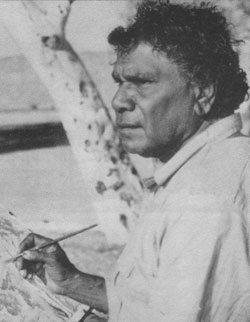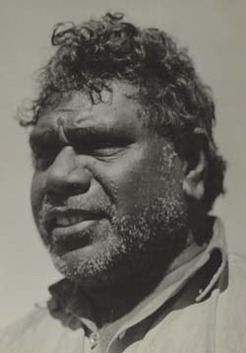| Namatjira Kngwarriya was an Indigenous Australian. Join: Indigenous Australians Project Discuss: INDIGENOUS_AUSTRALIANS |
Biography
Namatjira (Albert) Ngwarriya [1] was a western Aranda man [2] His birth was registered at the Hermannsburg Lutheran Mission on July 28, 1902. [3] [4] west of Alice Springs. His totem, when born was Elea, however, he learned to use a single name, Albert, which was bestowed upon him by the Lutheran Church when he was a child. [1] He used this single name publicly until 1938 when he was honoured with a solo exhibition and he was prompted to sign his paintings with two names. This led him for a short time to sign his paintings with the name Namatjira Albert in recognition of the totem inherited from his father. However, later he would change this to Albert Namatjira on the advice of promoters from the art world, who thought this would resonate more with purchasers [1]
On Christmas Eve 1905 Elea's father, Namatjirritja, and mother Ljukuta were baptised at the Hermannsburg Lutheran Mission, after receiving 3 years of religious instruction. They were bestowed with the English names Jonathan and Emelia (Emilie) [1]. Elea was baptised at the same time and given the name Albert. However, he did not use this name for many years. He lived at the Mission and at age thirteen was initiated as an Arrente custodial knowledge holder.
In 1920 he eloped with his partner Ilkalita, whom he was not supposed to associate with according to kinship protocols. As a result, of this elopement, he was not permitted to stay at the Mission and was absent for three years [1]. He used skills he had learned at the mission such as carpentry, saddlery, leatherwork and blacksmithing, as well as experience with shearing and shearer and working as a stockman to survive during this time. In the time he was away, he conceived three children with Illaita, Enos (1920-1966) [5], Oscar (1922-1991) [6] and Maisie (1923-?) [7]. Maisie was born on his return to Hermannsburg in 1923. At this time of the their return, Ilkalita was also baptised and given the name Rubina. This enabled Elea and Ilkalita to be officially married at the Mission and rejoing in its activities.
Not long after their return their second daughter Hazel was born but she died early, in 1949. Next to come along were Martha (1929-1950) and Ewald (1930-1984). During this phase of his life he started to help raise money for the Mission by producing items such as boomerangs that displayed burnt pokerwork designs and polished mulga wood plaques, which were decorated with designs of native flowers, and of Central Australian landscapes with emus and kangaroos, accurately observed in the foreground; a program started by Pastor Albrecht who ran the Mission. This was before he met watercolourist Rex Batterbee and fellow artist John Gardner in 1934, and showed an interest in doing similar work. He was quick to learn the techniques of watercolour painting and applied them to landscape painting from an early stage. [citation needed] His fourth son Keith (1937-1977) [8] was born before his first Solo Exhibition was opened in 1938 by Lady Huntingfield, wife of the Governor of Victoria in Melbourne, and for the first time, he started using his name Albert to sign his pictures. All his pictures were sold at this exhibition (see Korff, Jens, 2018) [citation needed], along with those of other Indigenous artists at the Hermannsburg Mission. Then his fifth son and last child, Maurice were born in 1939 and like Keith lived to the age of 40, passing away in 1979. [9]
In 1944 he became the first Arrente man to be entered in 'Who's Who in Australia'. [10] In 1946, His Royal Highness, the Duke of Gloucester, then Governor-General of Australia, who was accompanied by the Duchess, visited Albert and witnessed him painting in Standley Chasm, 40 km west of Alice Springs. More Solo Exhibitions followed in Melbourne, Sydney, Brisbane and Alice Springs to 1952. In 1953 he was awarded the Queen's Coronation Medal, and in 1954 he was presented at Government House to Her Majesty Queen Elizabeth II and the Duke of Edinburgh. In 1955 he was elected an honorary member of the Royal Art Society of New South Wales. In 1956 he was greatly affected by the death of his father Jonathon. In 1957 Albert and his wife, Rubina, were awarded Australian Citizenship. [11]
This led to one of Albert's darkest periods, in 1958, when he was convicted of supplying alcohol to another Aborigine. He was sentenced to six months imprisonment but after a drawn-out legal battle had that reduced to 3. The traumas that affected his life in the last few years seemed to have resulted in severe depression and he passed away at the Alice Springs Hospital from hypertensive heart failure on August 8, 1959, [3] [4] and was buried the next day in the Alice Springs Memorial Cemetery. [3] His old friend, Pastor Albrecht of the Hermannsburg Lutheran Mission conducted the service. His wife Rubina outlived him by 15 years, dying in 1974. He did his last paintings at Papunya shortly before his death.
In 1968, he had been honoured to be the first-named Arrente man to appear on a postage stamp. He was also honoured 34 years after his death, in 1993, with his Ghost Gum painting also on a 45c stamp [12]. In 2002 a whole series of postage stamps was issued in Australia to commemorate Namatjira's centenary.
Naming and Kinship
Suggested use of naming fields (please click on hyperlinks for definitions):
- Proper first name: Elea - this was the totem he was known by at birth and was his preferred name
- Preferred name: Namatjira - this was the totem he was known by as an adult. It was inherited from his father. This was the name he used privately amongst his family.
- Other nicknames: Albert Namatjira - Albert was a name bestowed upon him by the Lutheran Mission, when he was baptised, along with his parents in 1905, however, this name was not used in practice for quite sometime after that. After he started painting his used this single name "Albert" to sign his paintings. In 1938, when a solo exhibition of his work was planned, he was asked to use two names to sign his paintings. Initially, he used his totem as a first name Namatjira Albert, however, later he was requested to change this to "Albert Namatjira" as it was considered to be more marketable [1]
- Skin name: Elea's skin name is complicated as his mother and father eloped in a 'wrong' marriage. This had consequences, one of which was that he had two potential skin names, both of which had been tarnished, resulting in his father being speared before he could return to the Hermannsburg Mission. Elea was known to identify as Kngwarriya being the eldest son of his father; as opposed to Panangka after his mother, who already had children by a previous marriage. This was a choice that would not have to have been made in a sanctioned marriage as the inherited skin name would have been the same [13]
- Clan/family group: Western Arrernte
- Current Last Name: Kngwarriya - a individuals skin name remains with them for eternity. While Elea became renowned as the artist "Albert Namatjira", Namatjira was his totem and wrongly assumed to be a last name. Kngwarriya better describes his kinship relationships.
- Other Last Names: Panangka - this would have been Elea's skin name had his mother, Ljukuta married appropriately and was a potential skin name for Elea to identify with.
Sources
- ↑ 1.0 1.1 1.2 1.3 1.4 1.5 McKenzie, A (n.d.) Albert Namatjira: A Biographical Outline in 'In the Artist's Footsteps'; accessed 11 Dec 2020
- ↑ Aranda is also spelled Arunta, Arrernte or Arrarnta in various sources.
- ↑ 3.0 3.1 3.2 Find a Grave memorial for Albert Namatjira (28 Jul 1902–8 Aug 1959); accessed 13 December 2020; citing Alice Springs Memorial Cemetery, Alice Springs, Northern Territory, Australia.
- ↑ 4.0 4.1 Probate Index. Genealogical Society of the Northern Territory Inc. Darwin City, Northern Territory, Australia; Reference Number: 2083; File Name: E104 1959-65 Singles; Folio: E104; cited in Ancestry.com. Northern Territory, Australia, Probate Index, 1911-1994 [database on-line] Name: Albert Namatjira Death Age: 57 Birth Date: abt 1902 Residence Place: Hermannsburg, Northern Territory Death Date: 8 Aug 1959 Death Place: Alice Springs, Northern Territory Occupation: Aboriginal artist Reference Number: 2083
- ↑ https://thehermannsburgschool.org/enos-namatjira/
- ↑ https://thehermannsburgschool.org/oscar-namatjira/
- ↑ https://thehermannsburgschool.org/enos-namatjira/
- ↑ https://thehermannsburgschool.org/keith-namatjira/
- ↑ https://thehermannsburgschool.org/maurice-namatjira/
- ↑ Kleinert, S (2000) 'Namatjira, Albert (Elea) (1902–1959)', Australian Dictionary of Biography, National Centre of Biography, Australian National University.
- ↑ McLean, B. (2017, Jul 18) Namatjira Story in QAGOMA Blog; accessed 13 Dec 2020
- ↑ Lane, J. (2015, Mar 10) Albert Namatjira in Art Now and Then [blog]
- ↑ Edmond, M (2013) Double Lives: Rex Battarbee & Albert Namatjira by Martin Edmond, Doctoral Thesis, The University of Western Sydney
- http://archival.sl.nsw.gov.au/Details/archive/110322602 (letters written by Hazel, Namatjira's daughter
- https://nla.gov.au/nla.obj-141828508/view image of Namatjira and his family from 1946 by Alex Poignant
- Who's Who in Australia: 1944
- https://www.afr.com/life-and-luxury/arts-and-culture/albert-namatjira-80-years-on-the-untold-story-behind-his-first-exhibition-20180207-h0v7qz
- https://en.wikipedia.org/wiki/Indigenous_Australian_art#Contemporary_Indigenous_art
- https://www.creativespirits.info/aboriginalculture/people/famous-aboriginal-people-role-models#toc1
No known carriers of Namatjira's DNA have taken a DNA test. Have you taken a test? If so, login to add it. If not, see our friends at Ancestry DNA.
K > Kngwarriya > Elea Kngwarriya
Categories: Alice Springs Memorial Cemetery, Alice Springs, Northern Territory | Australia, Postage Stamps | Australia, Artists | Indigenous Australians | Hermannsburg Mission, Northern Territory | Alice Springs, Northern Territory | Arrernte | Indigenous Australians, Australia Managed Profiles | Australia, Notables in the Visual Arts | Notables







edited by Gillian Thomas
Namatjira was the totem of Enea's father. After being bestowed the name 'Albert' as a 'single' first name by the Lutheran Church, it would be used to sign his paintings. His traditional names were removed from him by the Hermannsburg mission. When he had his first solo exhibition in the 1930s, he was told that as an artist he should have two names. He began signing the paintings as Namatjira Albert taking his father's totem as a first name; as would appear appropriate to him. It was not until later that he was advised for legal reasons the identify this as a surname, despite this never being the case. This is how the name Namatjira first became associated with being a legal surname. It was a Western invention, which has since persisted.
His skin name (or last name) at birth was Kngwarriya. This name as significant in his life as at times it affected his relationship with Ilkalita. The name Namatjira only became a surname in the late 1930s at the behest of the art world which preferred to see it as a surname. As with the desire to see Albert posing with spears and a lack of clothing, this was designed to be able to sell more paintings, rather than the reflect his genealogy and traditions. So his LNAB was Kngwarriya and would remain so under the perspective of Arrente lore. His first name as a child was Enea. His first name as an adult was Namatjira. Under the direction of the art world and his Lutheran minders, his surname also became Namatjira, and by default so did his children. This is how the name Namatjira became associated with being a surname in Western culture in which Enea became renowned and suffered incredibly because of.
It would be great to see the naming fields of the profile shifted to represent these facts.